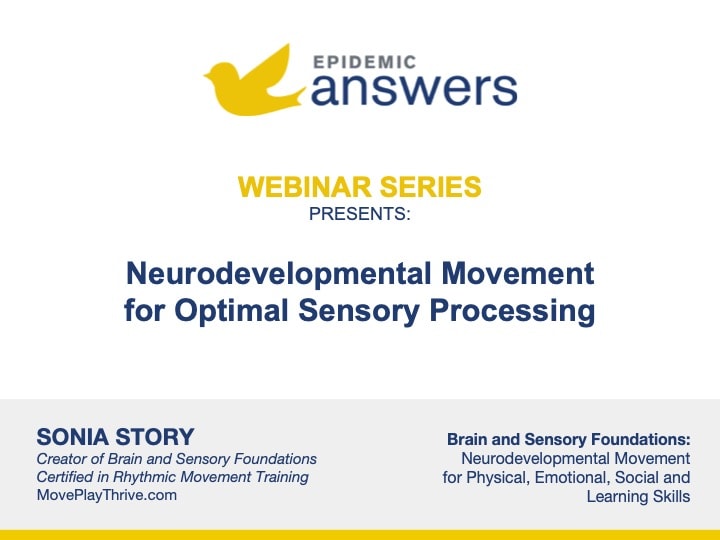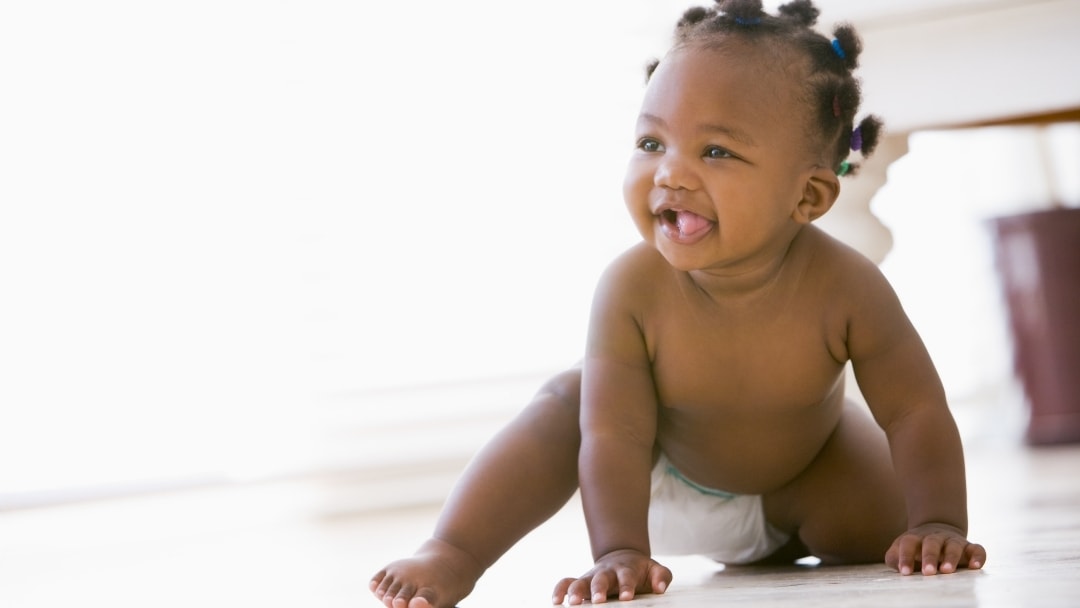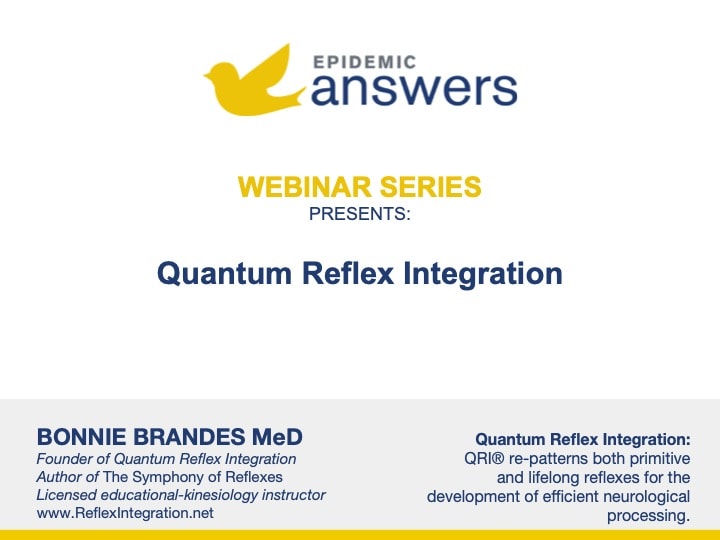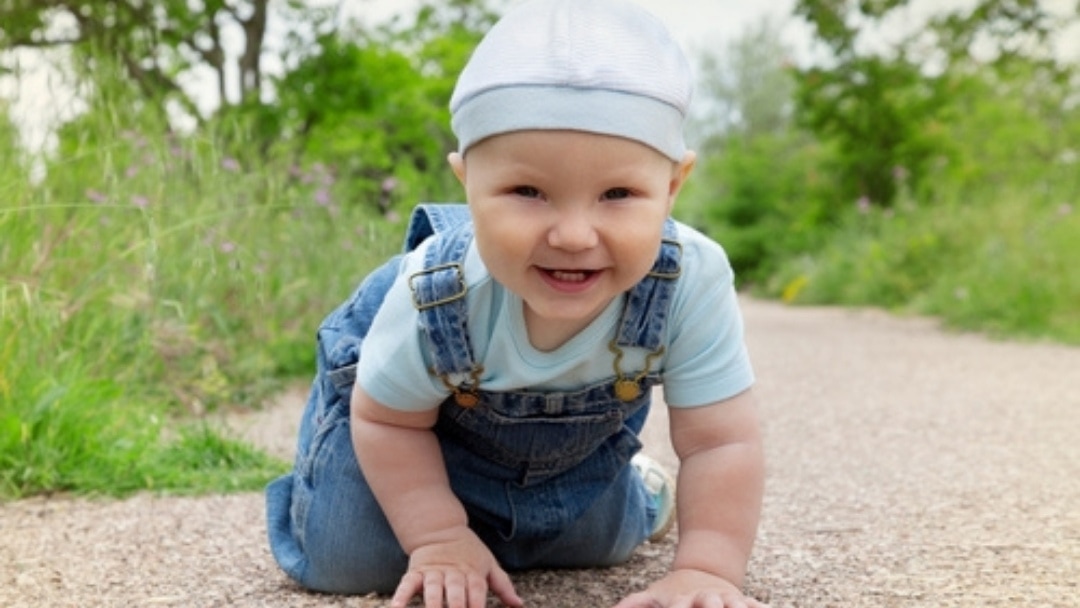Sonia Story of www.moveplaythrive.com explains how neurodevelopmental movement can help with symptoms of autism, ADHD, Sensory Processing Disorder and learning disabilities in this article.
Parents and therapists worldwide are learning joyful, transformative movements that help children thrive. These special neurodevelopmental movements are both calming and stimulating. They provide the foundations for sensory processing, emotional-social skills, cognitive skills, proper posture and health.
In the photos below the top set of babies have received sufficient neurodevelopmental movements to support proper posture, structural alignment and core strength. As a result, they are upright, alert and ready to explore their environment. The children in the bottom photos are slouched. They lack natural core strength and upright posture.
Note: On the bottom panel of photos, only the faces of the babies have been changed to protect privacy. The body positions are unaltered and shown exactly as photographed.*

Photo used with permission from Kathleen Porter, author of Sad Dog Happy Dog, How Poor Posture Affects Your Child’s Health and What You Can Do About It. http://www.naturalposturesolutions.com
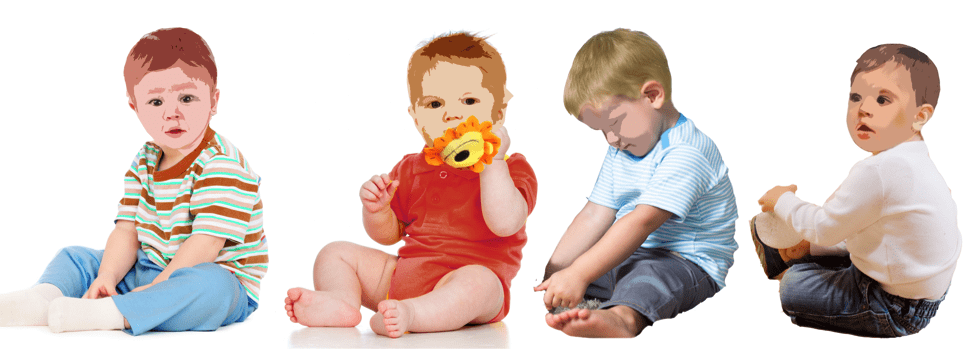
Photo used with permission from Kathleen Porter, author of Sad Dog Happy Dog, How Poor Posture Affects Your Child’s Health and What You Can Do About It.
Postural Strength Equals Brain Maturity
It is easy to recognize the difference in posture and alignment between the two sets of babies. What is far less obvious and less well known is that postural strength goes hand-in-hand with brain maturity. Sadly, the children below will be more likely to have difficulties with learning and development. Why?
Because brain maturity, like proper posture, is a direct result of receiving the full measure of our foundational neurodevelopmental movements in infancy. Fortunately, we can give neurodevelopmental movements at any age and the brain matures beautifully just as it would have if the movements had been accessible in infancy.
With completion of the neurodevelopmental movements, there is more brain maturity and profound positive changes. Along with better posture and strength, there is often better focus, impulse control, emotional regulation, and sensory processing. There is also more calm, greater ability to communicate, easier learning, better balance, and a deeper sense ease within the body.
Here is a real life example: Dylan is a 13-year-old boy with autism. His mother attended a training course in neurodevelopmental movement. After just one evening of neurodevelopmental movement, Dylan went to sleep calmly that evening, something he had never done before.
After two weeks, Dylan’s mother wrote about the remarkable changes she witnessed: “When we brush Dylan’s teeth, he usually pulls his upper lip over his teeth in a protective manner which makes it difficult to clean those front teeth. He usually screams and bites the tooth brush, now he is actually pulling his lip up to expose the teeth and there is no screaming of pain or discomfort. He has less resistance to task requests, more self control, and less reactive behavior.” (W. Payne, Tacoma, Washington).
In another case, Grady, a 6-year old boy, had anxiety and compulsive nail biting so severe his fingertips were raw and bloody. His mother learned four rhythmic neurodevelopmental movements in an introductory training. She did these movements at night while Grady slept and in small amounts during the daytime. The movements had a profound calming effect and very soon Grady stopped biting his nails. Within 10 days, his fingertips healed and though they were scarred, they were no longer bleeding and raw.
What Are Neurodevelopmental Movements?
Neurodevelopmental movements are natural movements. They are the innate, automatic movements that babies do in the womb and early infancy. All human babies will automatically engage in these neurodevelopmental movements as long as they are healthy, stress-free, have room to move and plenty of time on their bellies.
For many reasons in our modern society, these natural movements can be interrupted or hindered at the very beginning of life, leaving many children unable to complete their proper development. To varying degrees, these children suffer from an underdeveloped, immature neuro-sensory-motor system.
An immature neuro-sensory-motor system can manifest in many ways. For some children sitting still, focusing, and learning are difficult. Other children experience anxiety, stress, or depression throughout their daily lives. Others feel frustration and exhaustion because of the extra effort required to do daily tasks in an un-integrated state.
Some children have behavior challenges such as excessive defiance, phobias and compulsive tendencies are common. Many children have trouble falling to sleep and many do not sleep restfully. Huge numbers of children have mild to severe sensory processing disorders.
How Do Neurodevelopmental Movements Work?
From our earliest beginnings, movement drives the growth of our brain and nervous system. The infant neurodevelopmental movements build the foundation of the brain and neuro-sensory-motor system upon which development depends.
Imagine building a block tower. If the foundation is narrow and unsteady, the upper blocks are wobbly and prone to breakdowns. The same is true in human development.
We develop in stages, and like the block tower, we have a requirement for a proper foundation. If the infant neurodevelopmental movements are under utilized in infancy, the brain and neuro-sensory-motor system have a shaky foundation that can lead to challenges.
The likely reason the neurodevelopmental movements work so well is that the brain recognizes them as the same movements that mature the brain and sensory systems in infancy. The neurodevelopmental movements seem to have the capacity to wake up the brain and “reboot” our development.
According to Harald Blomberg, MD and Moira Dempsey, authors of the book, Movements That Heal, doing rhythmic neurodevelopmental movements activates critical links in the brain. This whole-brain linking creates optimal functioning and accounts for why the movements are so helpful in overcoming a large variety of conditions.
For over 30 years research studies have shown the connection between learning delays and un-integrated neurodevelopmental movements, also called primitive reflexes or primary movements. Clinical evidence and research also shows that when we give the neurodevelopmental movements to children with challenges, their learning improves along with their self-esteem and social life.
Parents as well as professionals can use easy-to-learn neurodevelopmental movements to help our children overcome challenges and better access their gifts.
*Photographs are from Natural Posture for Pain-Free Living (2013) and Sad Dog Happy Dog: How Poor Posture Affects Your Child’s Health (2010) by Kathleen Porter. www.naturalposturesolutions.com Used with permission.
Still Looking for Answers?
Visit the Epidemic Answers Practitioner Directory to find a practitioner near you.
Join us inside our online membership community for parents, Healing Together, where you’ll find even more healing resources, expert guidance, and a community to support you every step of your child’s healing journey.
Sources & References
Amos, P. Rhythm and timing in autism: learning to dance. Front Integr Neurosci. 2013 Apr 19;7:27.
Barnhill, E. Neural connectivity, music, and movement: a response to Pat Amos. Front Integr Neurosci. 2013 Apr 24;7:29.
Cho, H., et al. Effects of Action Observation Training with Auditory Stimulation on Static and Dynamic Balance in Chronic Stroke Patients. J Stroke Cerebrovasc Dis. 2020 May;29(5):104775.
Grigg, T.M., et al. Retained primitive reflexes: Perceptions of parents who have used Rhythmic Movement Training with their children. J Child Health Care. 2018 Sep;22(3):406-418.
Grzywniak, C. Integration exercise programme for children with learning difficulties who have preserved vestigial primitive reflexes. Acta Neuropsychologica. 2017;15(3).
Hardy, M.W., et al. Rhythm, movement, and autism: using rhythmic rehabilitation research as a model for autism. Front Integr Neurosci. 2013 Mar 28;7:19.
Herbert, J., et al. Crawling is associated with more flexible memory retrieval by 9-month-old infants. Dev Sci. 2007 Mar;10(2):183-9.
Hong, H.J., et al. Effect of Rhythmic Movement Program to Improve Walking Ability for Elderly Patients with Stroke. Indian Journal of Science and Technology. 2016 Jul;9(26).
Iverson, J.M. Developing language in a developing body: the relationship between motor development and language development. J Child Lang. 2010 Mar;37(2):229-61.
Jordan-Black, J. The effects of the Primary Movement programme on the academic performance of children attending ordinary primary school. Journal of Research in Special Educational Needs. 2005 Nov;5(3):101 – 111.
Kadivar, Z., et al. Effect of step training and rhythmic auditory stimulation on functional performance in Parkinson patients. Neurorehabil Neural Repair. 2011 Sep;25(7):626-35.
Ladányi, K. et al. Is atypical rhythm a risk factor for developmental speech and language disorders? Wiley Interdiscip Rev Cogn Sci. 2020 Sep;11(5):e1528.
Lakatos, P., et al. A New Unifying Account of the Roles of Neuronal Entrainment. Curr Biol. 2019 Sep 23;29(18):R890-R905.
McWhirter, K., et al. The association between learning disorders, motor function, and primitive reflexes in pre-school children: A systematic review. J Child Health Care. 2022 Jul 13;13674935221114187.
Melillo, R., et al. Persistent Childhood Primitive Reflex Reduction Effects on Cognitive, Sensorimotor, and Academic Performance in ADHD. Front Public Health. 2020 Nov 17;8:431835.
Suh, J.H., et al. Effect of rhythmic auditory stimulation on gait and balance in hemiplegic stroke patients. NeuroRehabilitation. 2014;34(1):193-9.
Van Hirtum, T., et al. Is atypical rhythm a riskfactor for developmental speech and language disorders? J Assoc Res Otolaryngol. 2021 Jul;22(4):465-480.
Winkler, I., et al. Newborn infants detect the beat in music. Proc Natl Acad Sci U S A. 2009 Feb 17;106(7):2468-71.
Zaigham, M., et al. Prelabour caesarean section and neurodevelopmental outcome at 4 and 12 months of age: an observational study. BMC Pregnancy and Childbirth. 2020 (20)564.
Zentner, M., et al. Rhythmic engagement with music in infancy. Proc Natl Acad Sci U S A. 2010 Mar 30;107(13):5768-73.
Resources
Where Do I Find Out More?
One of the best ways to learn about neurodevelopmental movements is through both live and online training courses. An excellent online course consisting of eight, multi-media training sessions is called Brain and Sensory Foundations. The course is designed for both parents and therapists who want to give neurodevelopmental movement programs for children.
Supporting Research
http://moveplaythrive.com/images/pdf/ResearchonReflexes.pdf
http://moveplaythrive.com/images/pdf/PostClass_Documents/reflexesgoneastray.pdf
Case Studies
http://moveplaythrive.com/testimonials.html
Books
Blomberg MD, Harald and Dempsey, Moira. Movements That Heal, Rhythmic Movement Training and Primitive Reflex Integration. Independenly published, 2011.
Brandes, Bonnie. The Symphony of Reflexes: Interventions for Human Development, Autism, ADHD, CP, and Other Neurological Disorders. CreateSpace Independent Publishing Platform, 2016.
Goddard Blythe, Sally. The Well Balanced Child: Movement and Early Learning. Hawthorn Press, 2005.
Goddard, Sally. Reflexes, Learning and Behavior, A Window Into the Child’s Mind. Fern Ridge Press, 2005.
Websites
Balance Brain Achievement Centers
Institute for Neuro-Physiological Psychology
My Child Will Thrive: Primitive Reflexes Cheat Sheet

